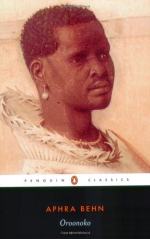|
This section contains 7,556 words (approx. 26 pages at 300 words per page) |

|
SOURCE: “The Disappearing African Woman: Imoinda in Oroonoko After Behn,” in ELH, Vol. 66, No. 1, 1999, pp. 71-86.
In the following essay, MacDonald discusses why the character of Oronooko's black African wife, Imoinda, in Aphra Behn's novel Oroonoko is depicted as white in later adaptations of the work. The critic claims that Imoinda's whiteness is used to suppress the facts of racial and gender conflict and to confer racial authority on white women.
At the climax of a mid-eighteenth-century heroic tragedy, the black hero, discovered in a private chamber with the dead body of his white wife, urges the white men who come upon the sight to “Put up your Swords, and let not civil Broils” involve them in his own desperate fate.1 The play in question is not a version of Othello, as the remark about (bright?) swords and civil broils might at first suggest, but rather John Hawkesworth's...
|
This section contains 7,556 words (approx. 26 pages at 300 words per page) |

|


